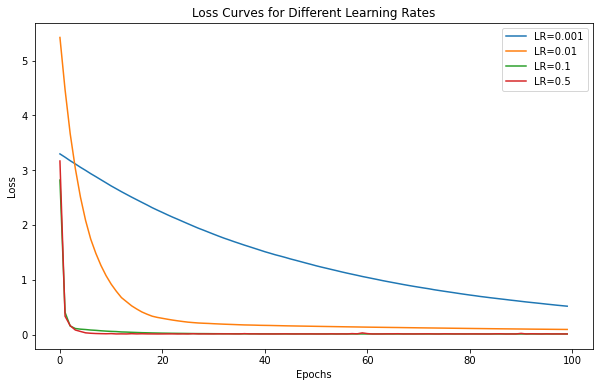Python TensorFlow: Experimenting with Learning Rates in Gradient Descent
Python TensorFlow Building and Training a Simple Model: Exercise-12 with Solution
Write a Python program to experiment with different learning rates in a gradient descent optimizer and observe the impact on convergence in TensorFlow.
Sample Solution:
Python Code:
import tensorflow as tf
import numpy as np
import matplotlib.pyplot as plt
# Generate some random data for a simple linear regression problem
np.random.seed(0)
X = np.random.rand(100, 1)
y = 2 * X + 1 + 0.1 * np.random.randn(100, 1)
# Define a range of learning rates to experiment with
learning_rates = [0.001, 0.01, 0.1, 0.5]
# Initialize a list to store training histories for each learning rate
training_histories = []
# Train models with different learning rates
for lr in learning_rates:
# Define the neural network model
model = tf.keras.Sequential([
tf.keras.layers.Input(shape=(1,)),
tf.keras.layers.Dense(1)
])
# Define the mean squared error (MSE) loss function
loss_function = tf.keras.losses.MeanSquaredError()
# Define the gradient descent optimizer with the current learning rate
optimizer = tf.keras.optimizers.SGD(learning_rate=lr)
# Compile the model with the optimizer and loss function
model.compile(optimizer=optimizer, loss=loss_function)
# Training loop
num_epochs = 100
history = model.fit(X, y, epochs=num_epochs, verbose=0)
training_histories.append(history.history['loss'])
# Plot the loss curves for different learning rates
plt.figure(figsize=(10, 6))
for i, lr in enumerate(learning_rates):
plt.plot(range(num_epochs), training_histories[i], label=f'LR={lr}')
plt.xlabel('Epochs')
plt.ylabel('Loss')
plt.legend()
plt.title('Loss Curves for Different Learning Rates')
plt.show()
Output:
Explanation:
Import Libraries:
import tensorflow as tf import numpy as npimport tensorflow as tf import numpy as np import matplotlib.pyplot as plt
Import the necessary libraries: TensorFlow (tf), NumPy (np), and Matplotlib (plt) for data generation and visualization.
-----------------------------------------------------
Generate Random Data:
np.random.seed(0) X = np.random.rand(100, 1) y = 2 * X + 1 + 0.1 * np.random.randn(100, 1)
Generate random input data X and target data y for a simple linear regression problem. X is a 2D array with 100 samples and 1 feature, and y is the corresponding target values.
------------------------------------------------------
Define Learning Rates to Experiment With:
learning_rates = [0.001, 0.01, 0.1, 0.5]
We define a list of learning rates to experiment with. You can adjust this list to include different learning rates you want to explore.
---------------------------------------------------------
Initialize a List for Training Histories:
training_histories = []
We create an empty list training_histories to store the training histories (loss curves) for each learning rate.
------------------------------------------------------------
Train Models with Different Learning Rates:
for lr in learning_rates:
model = tf.keras.Sequential([
tf.keras.layers.Input(shape=(1,)),
tf.keras.layers.Dense(1)
])
loss_function = tf.keras.losses.MeanSquaredError()
optimizer = tf.keras.optimizers.SGD(learning_rate=lr)
model.compile(optimizer=optimizer, loss=loss_function)
num_epochs = 100
history = model.fit(X, y, epochs=num_epochs, verbose=0)
training_histories.append(history.history['loss'])
- Loop through each learning rate (lr) in the learning_rates list.
- For each learning rate, we define a simple linear regression model with a single input feature and one output unit.
- Specify the mean squared error (MSE) loss function and the gradient descent optimizer with the current learning rate.
- The model is compiled with the optimizer and loss function.
- Train the model for a fixed number of epochs (num_epochs) and store the training loss history in the training_histories list.
------------------------------------------------------------
Plot Loss Curves:
plt.figure(figsize=(10, 6))
for i, lr in enumerate(learning_rates):
plt.plot(range(num_epochs), training_histories[i], label=f'LR={lr}')
plt.xlabel('Epochs')
plt.ylabel('Loss')
plt.legend()
plt.title('Loss Curves for Different Learning Rates')
plt.show()
- Finally, we use Matplotlib to plot the loss curves for different learning rates. Each learning rate's loss curve is displayed on the same plot for comparison.
- The x-axis represents the number of training epochs, and the y-axis represents the loss value.
- The legend shows the learning rates associated with each curve, allowing you to observe how different learning rates affect the convergence behavior of the model.
Go to:
PREV : Training Neural Networks with Adam Optimizer.
Python Code Editor:
Have another way to solve this solution? Contribute your code (and comments) through Disqus.
What is the difficulty level of this exercise?

